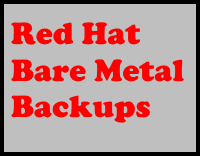Which is Best — Image Backups or File & Folder Backups?
 A perennial quandary for System Administrators everywhere concerns doing Image Backups or File & Folder Backups and which is better. Like all quandaries, there are opinions on both sides. And like the great beer commercial says Image Backups “taste great” but File & Folder Backups are “less filling.” Which to choose?
A perennial quandary for System Administrators everywhere concerns doing Image Backups or File & Folder Backups and which is better. Like all quandaries, there are opinions on both sides. And like the great beer commercial says Image Backups “taste great” but File & Folder Backups are “less filling.” Which to choose?
Image Backups are famous for being a complete backup. An Image Backup captures everything about a system: its operating system software, application programs, data files, and even application settings. In a disaster, you can rebuild an entire system from scratch with little more than a copy of your last Image Backup. This makes Image Backups attractive; so why not always do Image Backups?
- Image Backups have a dark side – their sheer size. If the server you’re imaging is 500-GB of used space, the Image Backup is 500-GB. This size causes trouble a number of ways. First, being large means it takes a long time to create the backup. If the backup is being sent to a tape library or server on your network, that 500-GB is sent over your network, slowing down the network for everyone. If you are trying to image more than one server every night, you may find your backups take so long that they run into the next business day. They may not even complete in a single day, which will cause you to miss backup nights.
- Storing these 500-GB backups will eat up your backup budget. Each backup takes disk space, tape space, or space from your cloud provider. One way or the other, this costs you money. The longer you keep these backups, the more money it costs.
- All is not rosy with Image Backups when it comes time to doing a restore. If the backup took hours to send over your network, it takes the same number of hours to pull it back over the network when doing a restore. To retrieve just a single file, it could take a while to find the Image, mount it, and pull data from it.
File & Folder Backups are an entirely different matter. File & Folder Backups only backup individual files that changed, so the backups can run fast. The amount of storage used is limited to the size of individual changes. This means keeping backups for months or even years is much more cost effective.
- A File & Folder Backup owes its speed to incremental changes being isolated to the file where the change took place. For example, if a user edits a 1-MB spreadsheet, they need to back up only that 1-MB file. This is a big savings on backup efficiency, not to mention storage costs.
- The downside to File & Folder Backups is their limitations on how you can use them when rebuilding a server from scratch. To rebuild a server requires you first reconstruct the server using the original operating system disks. Then reinstall your application programs. Then restore the files from the most recent backup. This is not as convenient as Image Backups, where the restored Image includes everything all in one.
Why do I have to choose when I like both?
Don’t make it an either/or choice. Instead combine both types of backups. The best solution is to perform nightly File & Folder Backups and intersperse periodic Image Backups. This solution solves two types of restore needs.
- File & Folder Backups address the most common restore request to recover just a single lost or corrupt file. With nightly File & Folder Backups, you can easily recover the file from last night’s backup. And since File & Folder Backups don’t take much space to store, you can keep them for longer and respond to requests to restore files deleted long ago.
- Image Backups – done periodically – address the need to quickly recover a server. If you need to rebuild a server from scratch, restore the most recent Image Backup. This restores the entire machine as it was when the Image Backup was made. Afterward, you restore last night’s File & Folder Backup, which restores all files changed since the Image Backup was created.
What’s the frequency?
There are two decisions you need to make with this hybrid backup model:
- How frequently to perform Image Backups
- How many Image Backups to retain
When considering how frequently to make an Image Backup, it’s best to consider how often the server’s installed applications change. Since most servers only infrequently change their installed applications, you can likely set Image Backups to take place once or twice a month. If you always get in the habit of initiating an Image Backup each time you install new software, you can set the Image Backup frequency to even less frequently, say quarterly.
When considering how many Image Backups to retain, pick a count that is likely further back than you’d want to recover. For example, if you perform a monthly Image Backup, ask yourself how likely you are to restore from a four (4) month old Image. In most cases, you’re likely to agree that this would be undesirable – so keeping more than 4 Image Backups is pointless.
Be careful about keeping too few Image Backups. If you keep too few, and it takes you a few days to recognize the need to recover your server, you could overwrite your last good backup. For example, say you did an Image Backup every week and choose to keep just a single Image Backup. If there is an office holiday, it could take a week or more before you’re back in the office and realize you need to recover your server.
Here’s what we recommend
- Nightly File & Folder Backup –
- Keep 90-days of File & Folder Backups
- Monthly Image Backups –
- Keep Three (3) Months of Image Backups
Carroll-Net was founded in 1994 with the singular goal of providing datacenter services our clients require at a price they can afford, delivered everywhere they need them. The industry now calls this cloud services — we call it common sense.
You might like some of our other articles…
 Red Hat Bare Metal Backups |  Red Hat Dynamic Routing |  Red Hat Traffic Shaping | Tools for Tracking Hackers |
